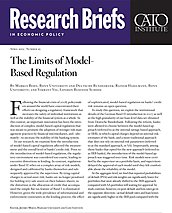In our research, we examine how the introduction of model-based capital regulation affected the measurement and the overall level of banks’ credit risk. Prior to the introduction of model-based regulation, the regulatory environment was considered too coarse, leading to excessive distortions in lending. In contrast, regulation under Basel II relies on a complex array of risk models, designed and calibrated by banks themselves and subsequently approved by the supervisor. By tying capital charges to actual asset risk, banks are no longer penalized for holding very safe assets on their balance sheets, so the distortion in the allocation of credit that accompanied the simple flat tax feature of Basel I is eliminated. However, given the wide prevalence of informational and enforcement constraints in the lending process, the effect of sophisticated, model-based regulation on banks’ credit risk remains an open question.
To study this question, we exploit the institutional details of the German Basel II introduction in 2007, as well as the high granularity of our loan-level data set obtained from Deutsche Bundesbank. Following the reform, banks were allowed to choose between the model-based approach (referred to as the internal ratings-based approach, or IRB), in which capital charges depend on internal risk estimates of the bank, and a more traditional approach that does not rely on internal risk parameters (referred to as the standard approach, or SA). Importantly, among those banks that opted for the new approach (referred to as IRB banks), the introduction of the model-based approach was staggered over time. Risk models were certified by the supervisor on a portfolio basis, and supervisors delayed the approval of each model until they felt comfortable about the reliability of the model.
At the aggregate level, we find that reported probabilities of default (PDs) and risk-weights are significantly lower for portfolios that were already shifted to the IRB approach compared with SA portfolios still waiting for approval. In stark contrast, however, ex-post default and loss rates go in the opposite direction — actual default rates and loan losses are significantly higher in the IRB pool compared with the SA pool. We also examine the interest rate that banks charge on these loans, as interest rates give us an opportunity to assess the perceived riskiness of these loans. Interest rates in the IRB pool are significantly higher than in the SA pool, suggesting that banks were aware of the inherent riskiness of these loan portfolios, even though reported PDs and riskweights did not reflect this. These results are present in every year until the end of the sample period in 2012 and are quite stable across the business cycle.
We also investigate differential effects on risk estimates for SA and IRB loans to the same firm. This within-firm analysis mitigates concerns related to omitted variables (such as macro factors) which may differentially affect SA and IRB loans. The loan-level analysis yields very similar insights. Even for the same firm in the same year, we find that both the reported PDs and the risk-weights are systematically lower, while the estimation errors (i.e., the difference between a dummy for actual default and the PD) are significantly higher for loans subject to the IRB approach vis-à-vis the SA approach. Again, the interest rates charged on IRB loans are higher despite the reported PDs and risk-weights being lower.
The high compliance costs associated with the modelbased approach meant that only the larger banks adopted it. These large banks benefited from the new regulation and expanded their lending, potentially at the expense of smaller banks. Specifically, we find that banks that opted for the model-based approach experienced a reduction in capital charges and consequently increased their lending by about 9 percent relative to banks that remained under the traditional approach. Thus, this complex, model-based regulation created barriers to entry and subsidized larger banks. This seems paradoxical, given the systemic risk associated with larger banks.
All in all, our results suggest that complex, modelbased regulation has failed to meet its objective of tying capital charges to actual asset risk. Counter to the stated objective of the reform, aggregate credit risk of financial institutions has increased.
Our findings have important policy implications. As a response to the financial crisis in 2007–2008, the Basel Committee has drafted a third revision of the regulatory framework for banks (Basel III). This framework continues to rely on model-based regulation, but further increases complexity to address substantial weaknesses of the old framework. While the measures might make sense individually, our results suggest that further increases in complexity are unlikely to increase financial stability. Our evidence supports the view that simpler and more transparent rules would be more effective in achieving the ultimate goal of financial stability.
NOTE
This research brief is based on “The Limits of Model-Based Regulation,” by Markus Behn, Rainer Haselmann, and Vikrant Vig, http://faculty.london.edu/vvig/index_files/BASEL_AUGUST_27.pdf.
